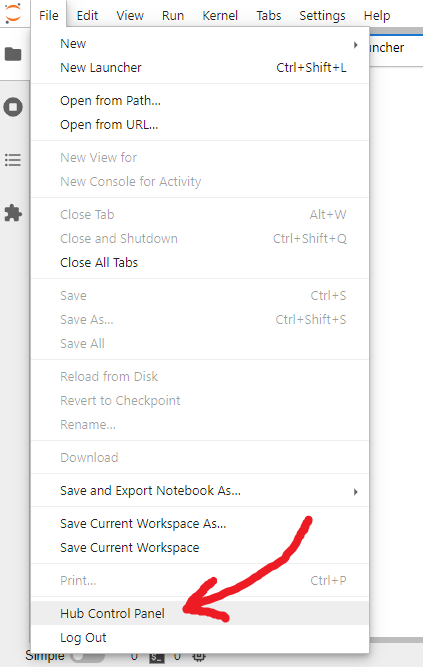mirror of
https://github.com/iiab/iiab.git
synced 2025-03-09 15:40:17 +00:00
93 lines
5.2 KiB
Markdown
93 lines
5.2 KiB
Markdown
## JupyterHub programming environment with student Notebooks
|
||
|
||
#### Secondary schools may want to consider JupyterHub to integrate coding with dynamic interactive graphing — A New Way to Think About Programming — allowing students to integrate science experiment results and program output within their own blog-like "Jupyter Notebooks."
|
||
|
||
* Jupyter Notebooks are widely used in the scientific community:
|
||
* [Institutional FAQ](https://jupyterhub.readthedocs.io/en/stable/getting-started/institutional-faq.html)
|
||
* [Getting Started](https://jupyterhub.readthedocs.io/en/stable/getting-started/)
|
||
* [JupyterLab changelog](https://github.com/jupyterlab/jupyterlab/releases)
|
||
* [JupyterHub changelog](https://jupyterhub.readthedocs.io/en/stable/changelog.html#changelog)
|
||
* Students create their own accounts on first use — e.g. at http://box.lan/jupyterhub — just as if they're logging in regularly (unfortunately the login screen doesn't make that clear, but the teacher _does not_ need to be involved!)
|
||
* A student can then sign in with their username and password, to gain access to their files (Jupyter Notebooks).
|
||
* The teacher should set and protect JupyterHub's overall `Admin` password, just in case. As with student accounts, the login screen unfortunately doesn't make that clear — so just log in with username `Admin` — using any password that you want to become permanent.
|
||
* Individual student folders are created in `/var/lib/private/` on the Internet-in-a-Box (IIAB) server:
|
||
* A student will only be able to see their own work — they do not have privileges outside of their own folder.
|
||
* Students may upload Jupyter Notebooks to the IIAB server, and download the current state of their work via a normal browser.
|
||
* Linux administrators can read more about JupyterHub's [Local Users](https://github.com/jupyterhub/systemdspawner#local-users) and [c.SystemdSpawner.dynamic_users = True](https://github.com/jupyterhub/systemdspawner#dynamic_users)
|
||
|
||
### Settings
|
||
|
||
Linux administrators may want to review `/opt/iiab/jupyterhub/etc/jupyterhub/jupyterhub_config.py` which originates from:
|
||
|
||
https://github.com/iiab/iiab/blob/master/roles/jupyterhub/templates/jupyterhub_config.py.j2
|
||
|
||
In some rare circumstances, it may be necessary to restart JupyterHub's systemd service:
|
||
|
||
```
|
||
sudo systemctl restart jupyterhub
|
||
```
|
||
|
||
FYI `/opt/iiab/jupyterhub` is a Python 3 virtual environment, that can be activated (and deactivated) with the usual:
|
||
|
||
```
|
||
source /opt/iiab/jupyterhub/bin/activate
|
||
(jupyterhub) root@box:~# deactivate
|
||
```
|
||
|
||
Passwords are hashed using 4096 rounds of the latest Blowfish (bcrypt's $2b$ algorithm) and stored in:
|
||
|
||
```
|
||
/opt/iiab/jupyterhub/etc/passwords.dbm # Or passwords.dbm.db in the past.
|
||
```
|
||
|
||
### Users can change their own password
|
||
|
||
Users can change their password by logging in, and then visiting URL: http://box.lan/jupyterhub/auth/change-password
|
||
|
||
NOTE: This is the only way to change the password for user `Admin`, because **File > Hub Control Panel > Admin** (below) does not permit deletion of this account.
|
||
|
||
### File > Hub Control Panel > Admin, to manage accounts
|
||
|
||
The `Admin` user (and any users given `Admin` privilege) can reset user passwords by deleting the user from JupyterHub's **Admin** page (below). This logs the user out, but does not remove any of their data or home directories. The user can then set a new password in the usual way — simply by logging in. Example:
|
||
|
||
1. As a user with `Admin` privilege, click **File > Hub Control Panel** in your JupyterHub:
|
||
|
||

|
||
|
||
2. At the top of the Control Panel, click **Admin**:
|
||
|
||

|
||
|
||
This opens up the JupyterHub Admin page, where you can add / delete users, start / stop peoples’ servers and see who is online.
|
||
|
||
3. Delete the user whose password needs resetting. Remember this does not delete their data or home directory:
|
||
|
||

|
||
|
||
If there is a confirmation dialog, confirm the deletion. This will also log the user out, if they were currently running.
|
||
|
||
4. Re-create the user whose password needs resetting, on this same screen.
|
||
|
||
5. Ask the user to log in, but with a new password of their choosing. This will be their password going forward.
|
||
|
||
_WARNING: If on login users see "500 : Internal Server Error", you may need to remove ALL files of the form_ `/run/jupyter-johndoe-singleuser`
|
||
|
||
### Logging
|
||
|
||
To see JupyterHub's (typically very long!) log, run:
|
||
|
||
```
|
||
journalctl -u jupyterhub
|
||
```
|
||
|
||
Sometimes other logs might also be available, e.g.:
|
||
|
||
```
|
||
journalctl -u jupyter-admin-singleuser
|
||
```
|
||
|
||
### PAWS/Jupyter Notebooks for Python Beginners
|
||
|
||
While PAWS is a little bit off topic, if you have an interest in Wikipedia, please do see this 23m 42s video ["Intro to PAWS/Jupyter notebooks for Python beginners"](https://www.youtube.com/watch?v=AUZkioRI-aA&list=PLeoTcBlDanyNQXBqI1rVXUqUTSSiuSIXN&index=8) by Chico Venancio, from 2021-06-01.
|
||
|
||
He explains PAWS as a "powerful Python execution environment https://paws.wmcloud.org = https://wikitech.wikimedia.org/wiki/PAWS [allowing] ordinary folks to write interactive scripts to work with Wikimedia content."
|